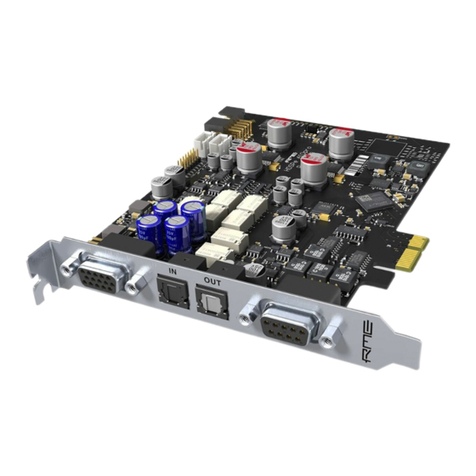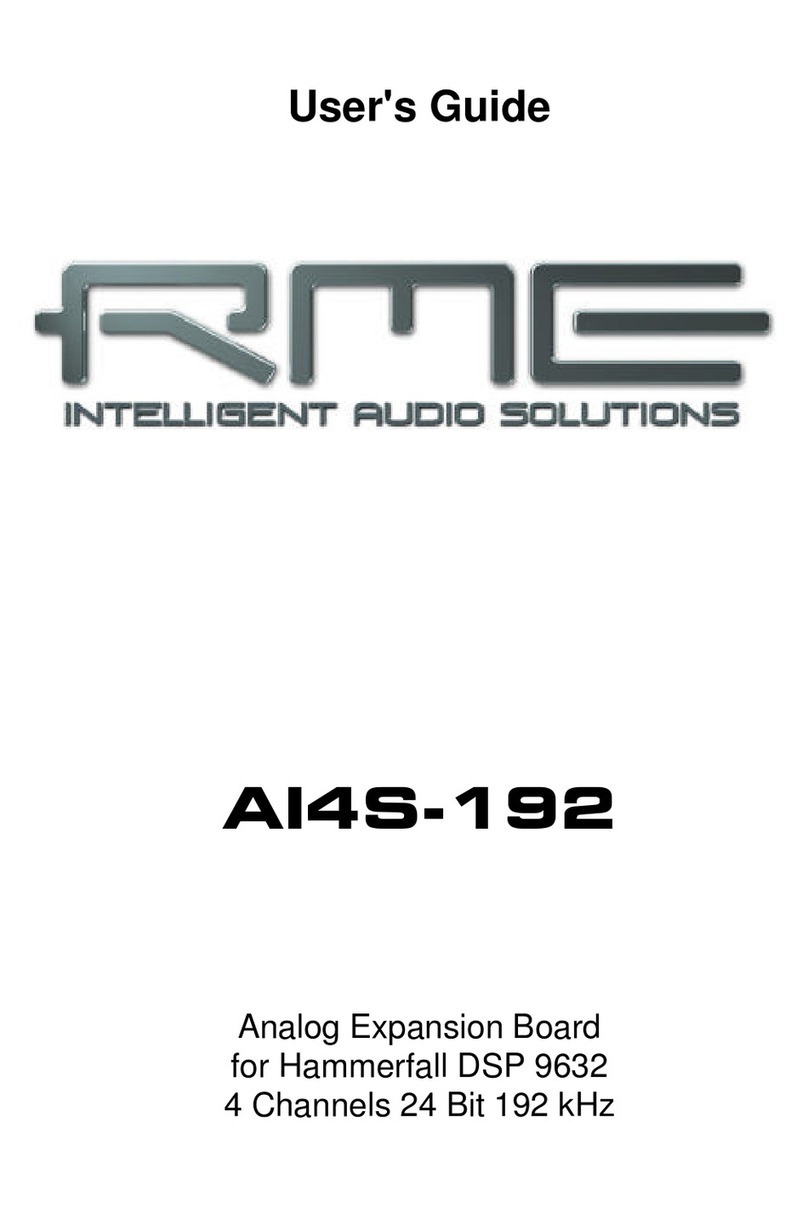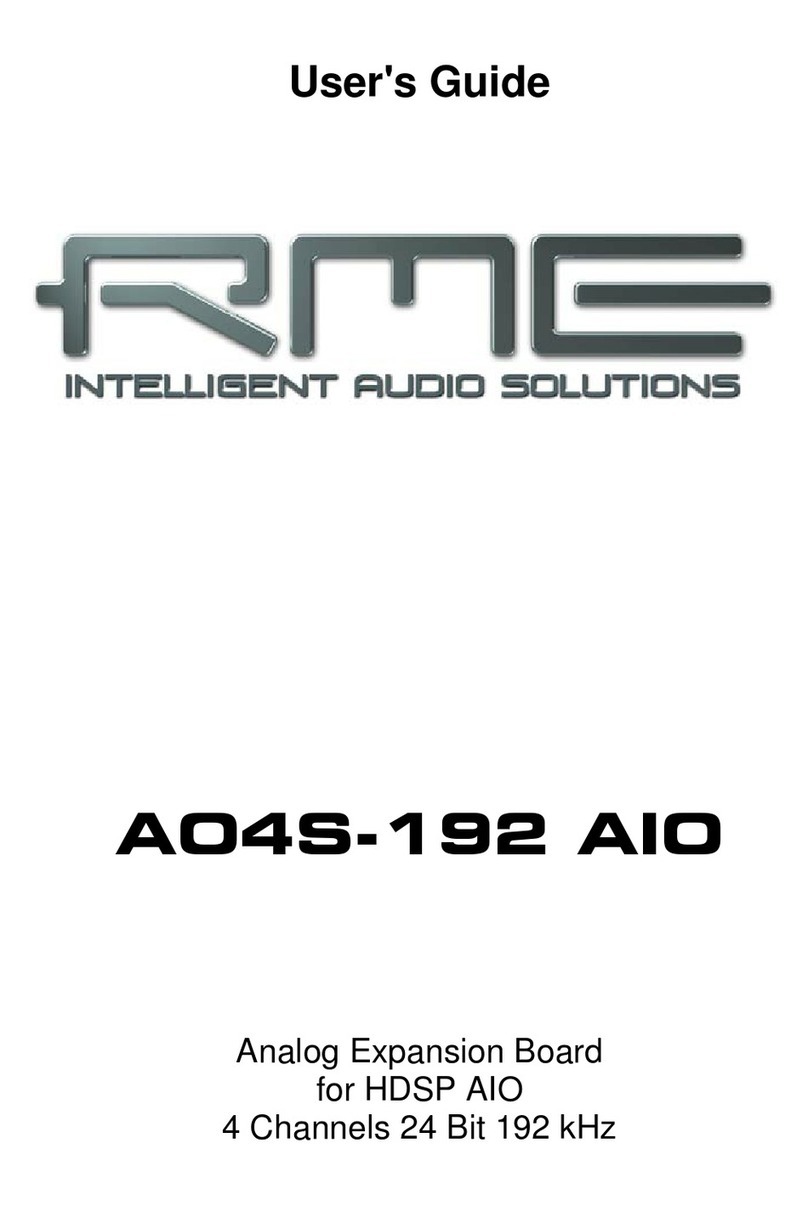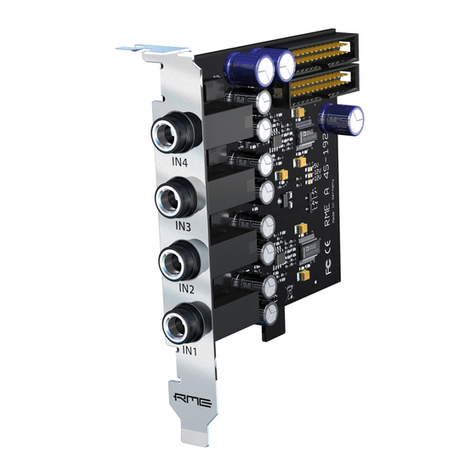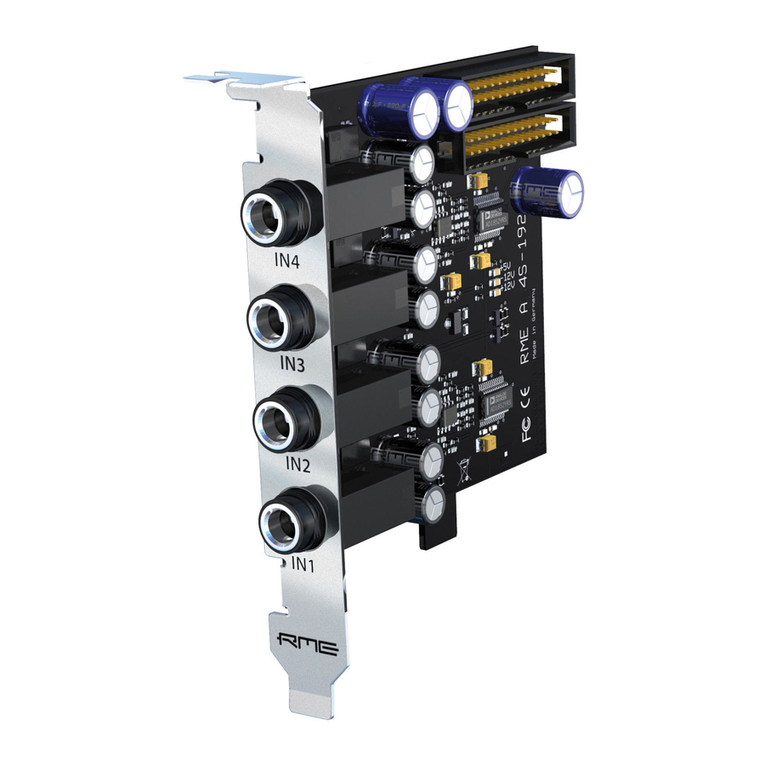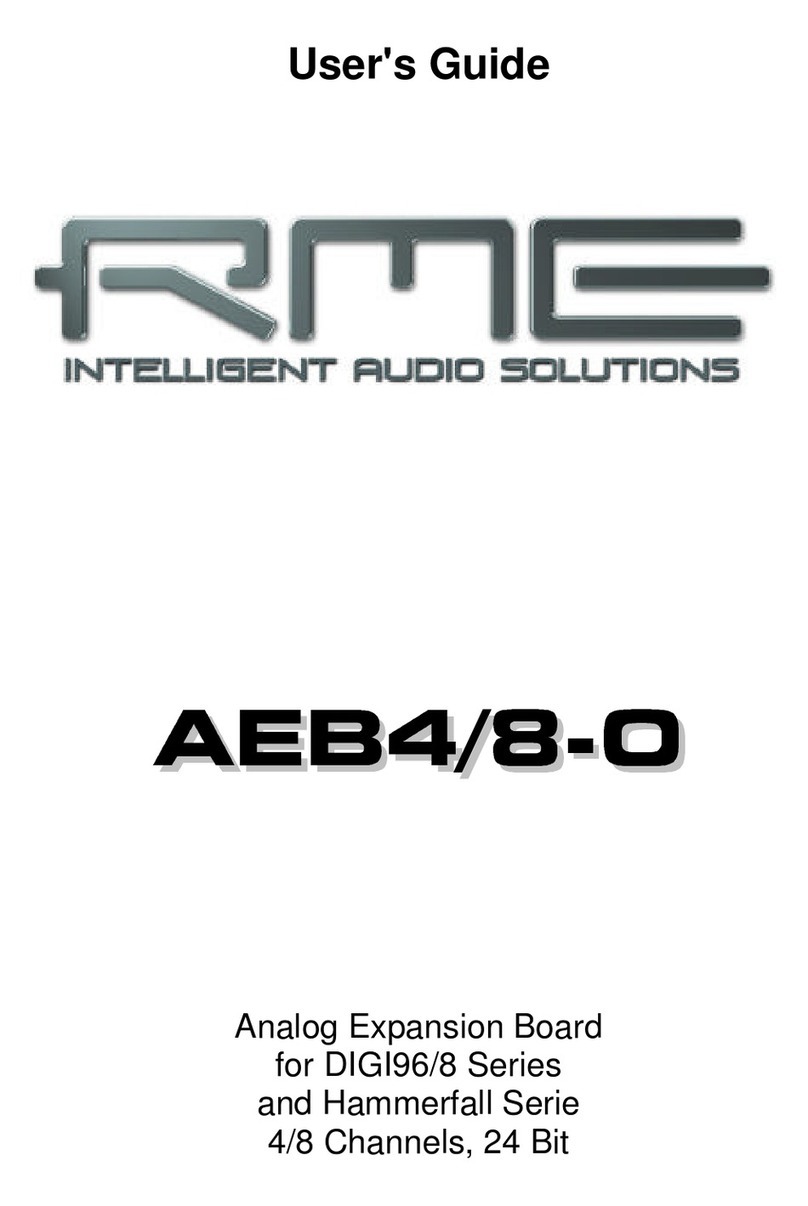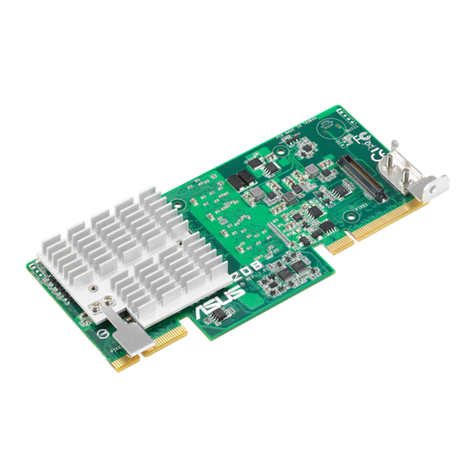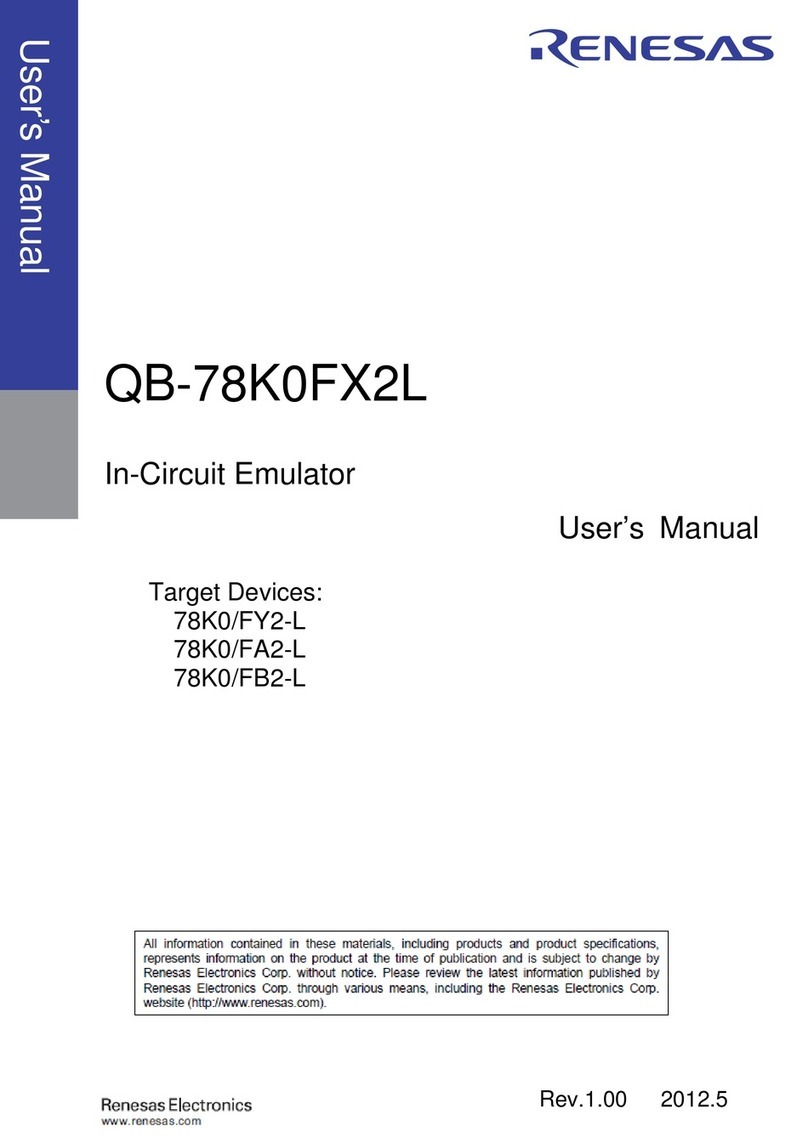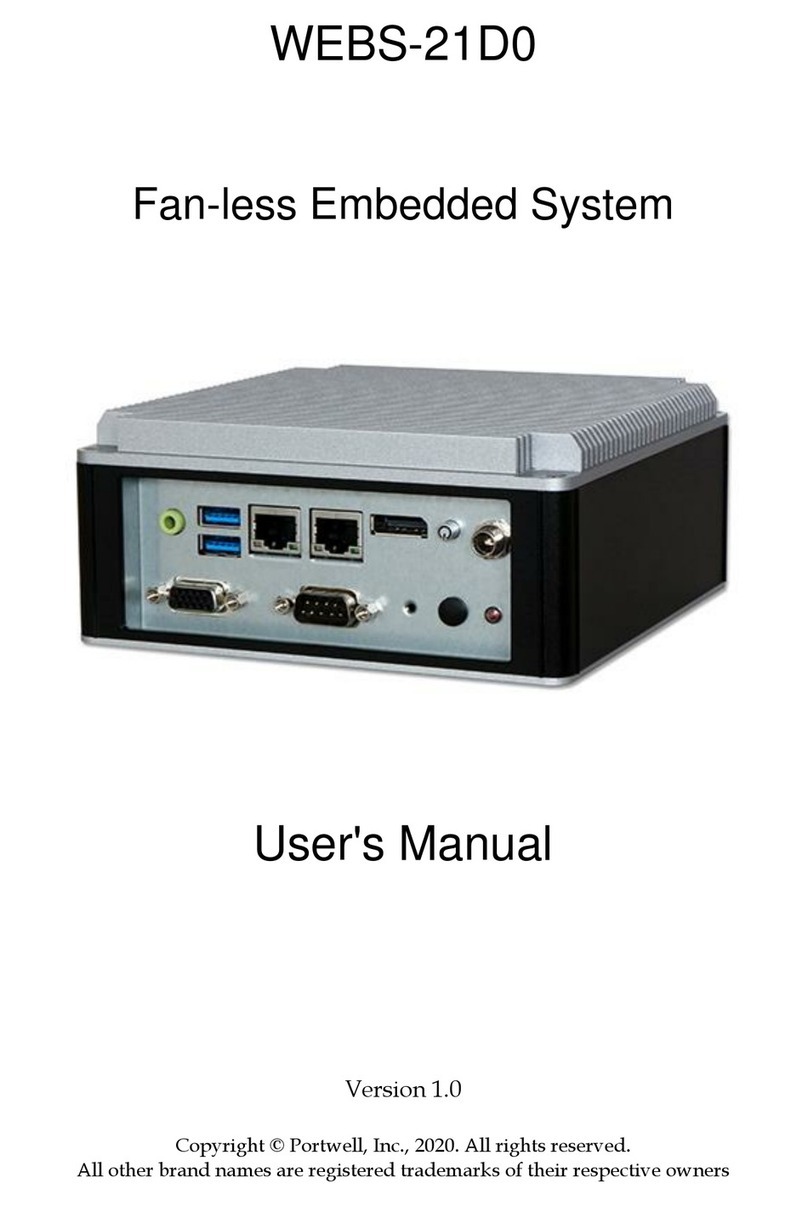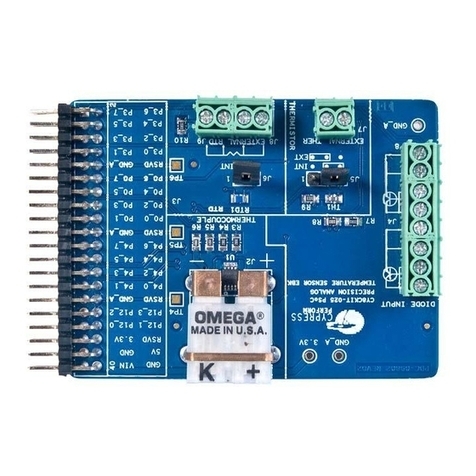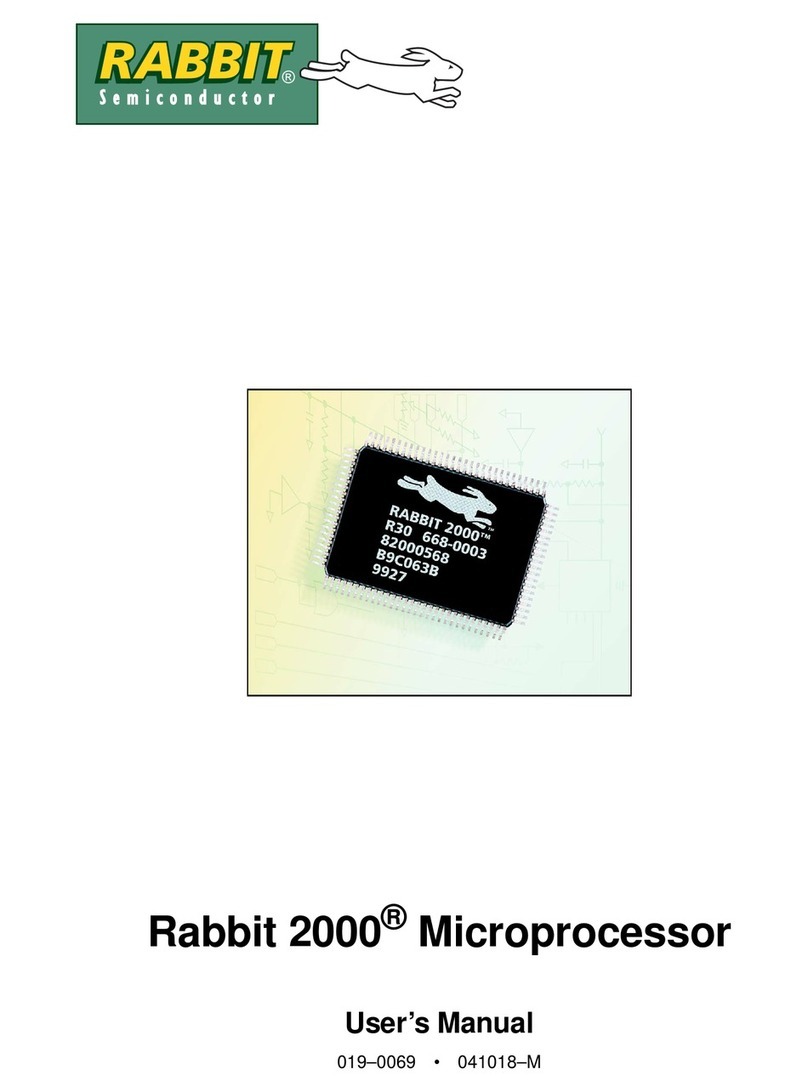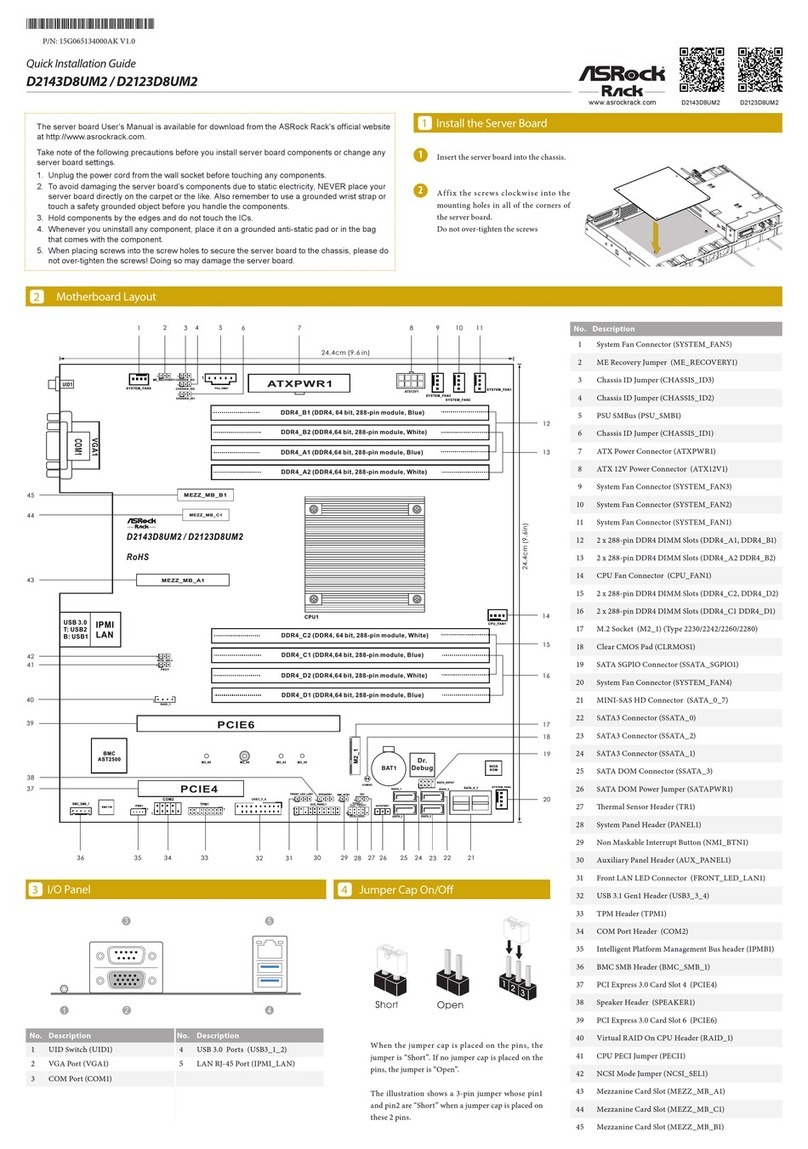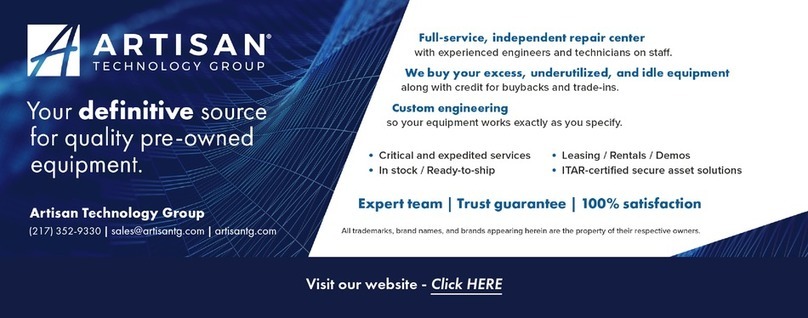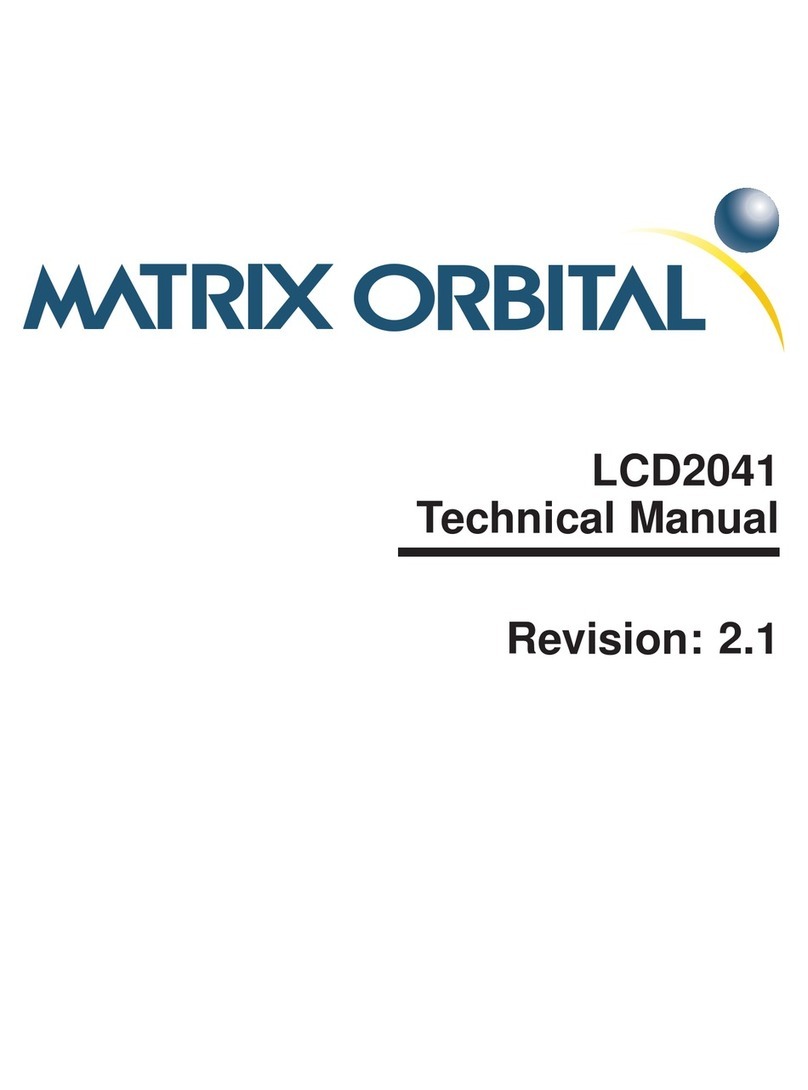RME Audio AEB4/8-1 User manual

User's Guide
Analog Expansion Board
for DIGI96/8 Series, Hammerfall Series
and HDSP 9652
4/8 Channels, 24 Bit

User's Guide AEB4/8-I
2
Contents
1Introduction.............................................................. 3
2Package Contents.................................................... 3
3Hardware Requirements........................................... 3
4Technical Specifications........................................... 4
5Hardware Installation................................................ 4
6Alternative Installation.............................................. 6
7Operation and Usage ............................................... 7
8Channel Routing AEB4-I .......................................... 7
9Pin assignment of the TRS jacks.............................. 7
10 Warranty.................................................................. 8
11 Appendix.................................................................. 8

User's Guide AEB4/8-I
3
1. Introduction
Thank you for choosing the RME AEB technology. The Analog Expansion Boards add 4 or 8
analog inputs in professional quality to RME's digital audio cards. Level adjustment +4 dBu/-10
dBV, 107 dBA SNR and highest suppression of PC-noise guarantee perfect sound quality.
2. Package Contents
Please ensure that all the following parts are included in the AEB's packaging box:
•Analog Expansion Board
•1 Clock cable 3-core
•1 Data cable 2-core
•1 Cable adapter 5 ¼" to 2 x 3,5"
•1 Set of nuts
•Manual, drill template
3. Hardware Requirements
AEBs can only be used with RME cards.
DIGI96 Series
AEBs use the internal ADAT interface of the DIGI cards. Therefore they do not work with the
DIGI96 (which did not support ADAT). To operate the AEB4-I and AEB8-I the used DIGIs must
have the connectors ST6/7 on board (for the Word Clock Module). These were not present on
the very first cards of the DIGI96 series (1998 to beginning of 1999). DIGI96/8 revision 1.2 or
lower have no connector ST7 (introduced with rev. 1.3, the blue board).
One AEBx-I and one AEBx-O can be connected and operated simultaneously, in all possible
combinations.
Hammerfall Series
An operation with the Hammerfall or Hammerfall Light requires board revision 1.5 or higher,
because the internal connectors ADAT1Out, ADAT2Out and ST7 were not implemented in
earlier versions.
One AEBx-I and two AEBx-O can be connected and operated simultaneously, in all possible
combinations.
HDSP 9652
Two AEBx-I and two AEBx-O can be connected and operated simultaneously, in all possible
combinations.
Hammerfall DSP Multiface / Digiface
Multiface and Digiface use the Hammerfall DSP PCI card. This card has no internal inputs or
outputs. Therefore no Expansion Boards can be used.

User's Guide AEB4/8-I
4
4. Technical Specifications
•Input AEB4-I: 4 x 1/4" TRS jack, servo balanced
•Input AEB8-I: 4 x 1/4" TRS jack, unbalanced
•Dynamic ratio: 104 dB (RMS unweighted), 107 dBA
•THD+N: -95 dB (0.0017 %)
•Frequency response -0.1 dB: 10 Hz -21 kHz
•Input level for 0 dBFS @ +4 dBu: +12 dBu
•Input level for 0 dBFS @ -10 dBV: +2 dBV
•Crosstalk: > 110 dB
•Supported sample rates: 32 kHz -48 kHz
•Input impedance: 10 kOhm
•Power supply uses 3.5" floppy connector, 12 V/5 V DC, 190 mA
•Standard bracket, board dimensions AEB4: 85 x 95 mm, AEB8: 120 x 95 mm
5. Hardware Installation
Important: Switch off the computer and remove the power cable from the power supply be-
fore fitting the AEB.
1. Disconnect the power cable and all other cables from the computer.
2. Remove the PC housing; further information on how to do this can be obtained from your
computer´s instruction manual.
3. Neutralize the static build up by touching the PC metal-chassis before unpacking the AEB
from the protective bag.
4. Connect AEB and PCI-card using the supplied 3-wire cable. Plug one end into the connector
ST7 on the PCI-card, the other end into ST7A on the AEB.
5. Connect the AEB's DIG OUT and the PCI-card's CD-IN/Sync-In using the supplied 2-wire
cable. Watch out for correct polarity: The shield wire is black, and must be connected to the
pin marked GND on the PCI-card (the right one).
6. Connect power supply: The AEB uses a floppy power connector (3,5"). In case no such con-
nector is available use the supplied adapter cable to connect the AEB to any free 5 ¼" power
connector.
7. Insert the AEB into a free slot, press and fasten the screw. The AEB needs no slot on the
motherboard, but includes a stabilizing edge, which fits in both PCI and ISA slots.
8. Re-insert the PCI-card in a PCI slot and fasten the screw.
9. Re-place the PC housing and tighten the screws.
10.Re-connect the power cable and all other cables/connections.

User's Guide AEB4/8-I
5
Connecting an AEBx-I to a DIGI96/8 PAD
Connecting an AEBx-I to a Hammerfall

User's Guide AEB4/8-I
6
Connecting an AEBx-I to the second ADAT In of
a HDSP 9652. Remove the jumper ST5, plug
DIGOUT of the AEBx-I on both right and middle
pin of ST5.
When using two AEBx-I, the PCI card’s word
clock signal will be daisy chained through the
AEBs. For this to work, connect ST7 of the
HDSP 9652 with ST7A of the first AEB. Then
connect ST7B of the first AEB with ST7A of
the second AEB.
6. Alternative Installation
Installation is done comfortably as described using the attached bracket. Alternatively it is pos-
sible to mount the AEB at a different place inside the computer using the supplied nuts. This
requires to drill 4 holes into the housing.
RME does not accept claims for damages of any kind when installing the AEB in this
way! Modifications to the housing should be done by qualified technicians only, and
only after having removed all components from the housing (danger of short circuit
by metal splinter etc).
1. Remove the bracket from the AEB (2 screws).
2. Carefully check that the desired location offers a flat plane, is free from any voltage carrying
devices or cables, and that the AEB does not get in contact with other devices even when
the housing is closed.
3. Please note that the lenght of the supplied cables does not allow any distance to the DIGI
card.
4. Drill 4 holes, diameter 0.5" (13 mm), distance of 0.75" (19.05 mm) each, at the desired
place (see drill template).
5. Fit the AEB into the holes and fix it with the supplied nuts.

User's Guide AEB4/8-I
7
7. Operation and Usage
Switch on the computer and boot the OS. The green LED on the AEBx-I is lit when the power
supply is present.
DIGI96 series
Start the Settings dialog of the DIGI96/8 series, select the internal input (Input 'Internal'), set
Clock Mode to 'Master'. The Input Status must now show 'ADAT, 44.1 kHz, Internal' (or 48
kHz). In case 'No Lock' is shown either the sample rate at the card's output is below 44.1 kHz
(see Output Status), or the AEB is not connected correctly.
Hammerfall series and HDSP 9652
Start the Settings dialog of the Hammerfall, select the internal input (AEB 'ADAT1 Internal'), set
Clock Mode to 'Master'. The Input Status in the field SyncCheck must now show 'ADAT1 In
SYNC'. In case 'Lock' or 'No Lock' is shown either the sample rate at the card's output is 32 kHz
(see Sync Ref., Freq.), or the AEB is not connected correctly.
Note
The AEB gets its clock directly from the output of the DIGI card. To avoid a clock loop the card
has to be set into 'Master' mode.
8. Channel Routing AEB4-I
The AEB4-I copies all 4 analog input signals to the corresponding channels 5-8. Therefore for
example the first two channels can also be recorded using the wave device 5/6.
9. Pin assignment of the TRS jacks
The analog inputs are accessible through stereo ¼" TRS jacks.
The AEB4-Iis fitted with electronically balanced, single channel inputs (+ = tip). The servo
balanced input circuit allows to use monaural TS jacks (unbalanced) with no loss in level.
The AEB8-Iis fitted with unbal-
anced stereo inputs. Use an
adapter TRS plug to coaxial
(phono) plugs, or TRS plug to TS
plugs (see drawing to the right) for
connection to external equipment.
We recommend to use so called
'insert' cables.
The pin assignment follows interna-
tional standards. The left channel is
connected to the tip, the right chan-
nel to the ring of the TRS jack/plug.

User's Guide AEB4/8-I
8
10. Warranty
Each individual AEB undergoes comprehensive quality control and a complete test in a PC
environment at RME before shipping. The usage of high grade components allows us to offer a
full two year warranty. We accept a copy of the sales receipt as valid warranty legitimation.
RME’s replacement service within this period is handled by the retailer. If you suspect that your
card is faulty, please contact your local retailer. The warranty does not cover damage caused
by improper installation or maltreatment -replacement or repair in such cases can only be car-
ried out at the owner’s expense.
RME does not accept claims for damages of any kind, especially consequential damage. Liabil-
ity is limited to the value of the AEB. The general terms of business drawn up by Synthax Au-
dio AG apply at all times.
11. Appendix
RME news, driver updates and further product information are available on our website:
http://www.rme-audio.com
If you prefer to read the information off-line, you can load a complete copy of the RME website
from the RME Driver CD (in the \rmeaudio.web directory) into your browser.
Trademarks
All trademarks and registered trademarks belong to their respective owners. RME, DIGI96 and
Hammerfall are registered trademarks of RME Intelligent Audio Solutions. Alesis and ADAT are
registered trademarks of Alesis Corp. ADAT optical is a trademark of Alesis Corp.
Copyright Matthias Carstens, 12/2002. Version 1.3
Current driver version: W98: 4.96, NT 3.85, W2k: 2.023 / 2.43
Although the contents of this User’s Guide have been thoroughly checked for errors, RME can not guarantee that it is correct
throughout. RME does not accept responsibility for any misleading or incorrect information within this guide. Lending or
copying any part of the guide or the RME drivers CD, or any commercial exploitation of these media without express written
permission from RME Intelligent Audio Solutions is prohibited. RME reserves the right to change specifications at any time
without notice.

User's Guide AEB4/8-I
9
CE
This device has been tested and found to comply with the limits of the European Council Direc-
tive on the approximation of the laws of the member states relating to electromagnetic com-
patibility (EMVG) according to EN 55022 class B and EN50082-1.
FCC Compliance Statement
Certified to comply with the limits for a Class B computing device according to subpart J or part
15 of FCC rules. See instructions if interference to radio reception is suspected.
FCC Warning
This equipment has been tested and found to comply with the limits for a Class B digital de-
vice, pursuant to part 15 of the FCC rules. These limits are designed to provide reasonable
protection against harmful interference in a residential installation.
This device complies with part 15 of FCC rules. Operation is subject to the following two condi-
tions:
1. This device may not cause harmful interference
2. This device must accept any interference received, including interference that may cause
undesired operation.
However, there is no guarantee that interference will not occur in a particular installation. If this
equipment does cause harmful interference to radio or television reception, which can be de-
termined by turning the equipment off and on, the user is encouraged to try to correct the inter-
ference by one or more of the following measures:
•Reorient or relocate the receiving antenna
•Increase the seperation between the equipment and receiver
•Connect the equipment into an outlet on a circuit different from that to which the receiver is
connected
•Consult the dealer or an experienced radio/TV technician for help.
In order for an installation of this product to maintain compliance with the limits for a Class B
device, shielded cables must be used for the connection of any devices external to this prod-
uct.
This manual suits for next models
2
Table of contents
Other RME Audio Computer Hardware manuals
Popular Computer Hardware manuals by other brands
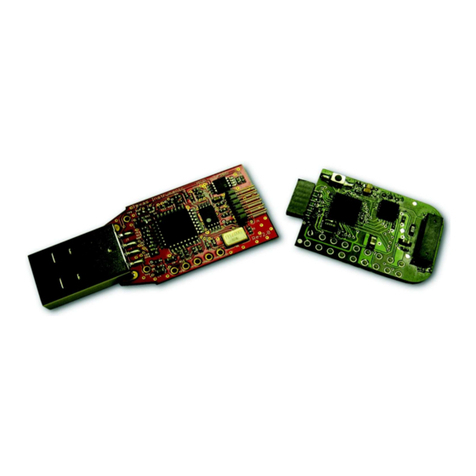
Texas Instruments
Texas Instruments eZ430-TMS37157 user guide
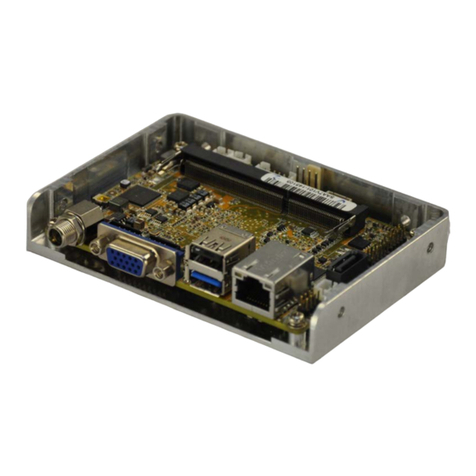
IEI Technology
IEI Technology HYPER-BT-E38 1 Series user manual
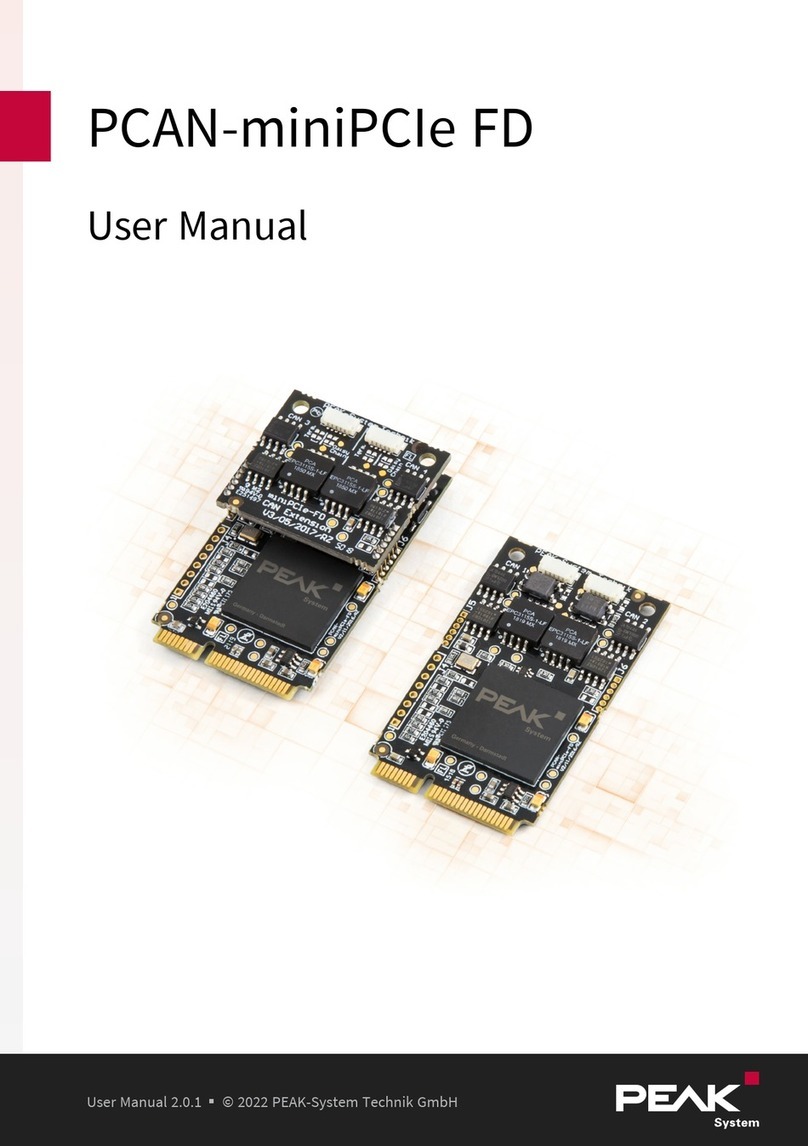
Peak
Peak PCAN-miniPCIe FD user manual
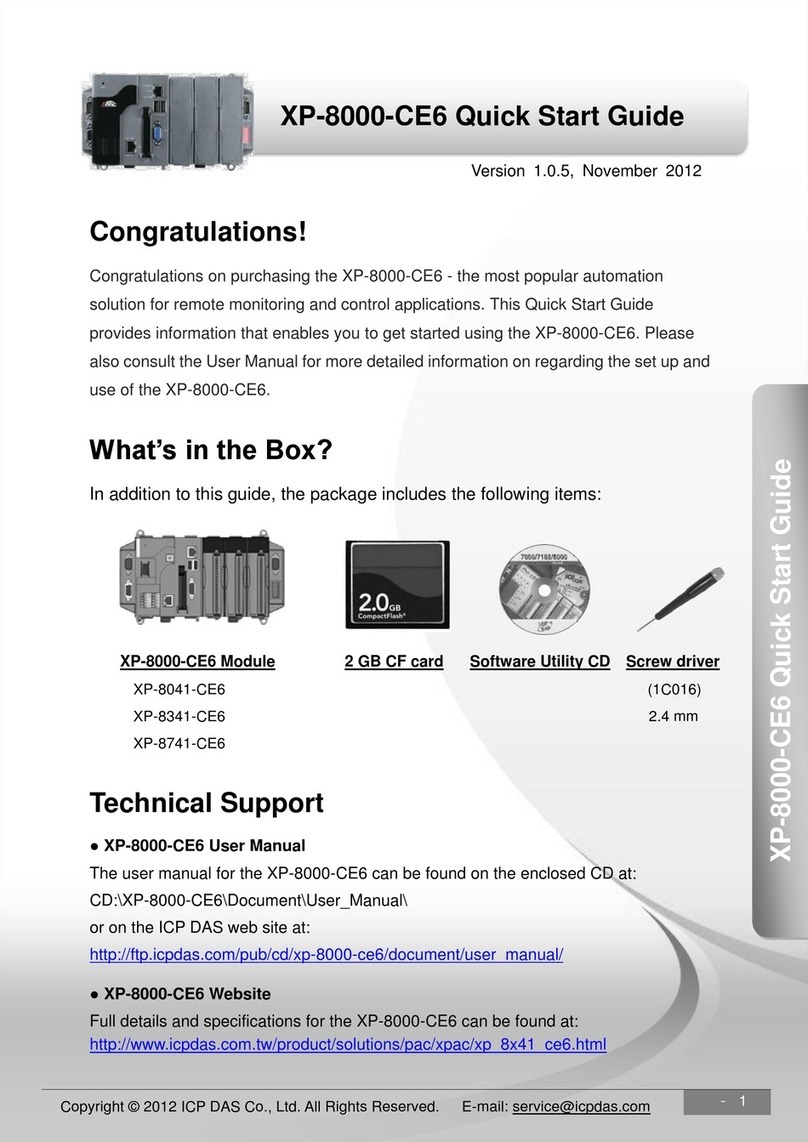
ICP DAS USA
ICP DAS USA XP-8000-CE6 quick start guide
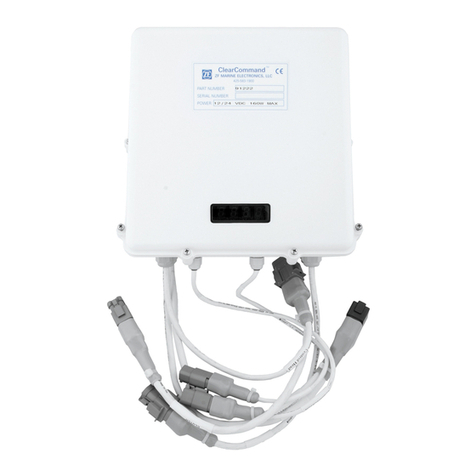
ZF
ZF MM9000 Installation, operation and troubleshooting manual
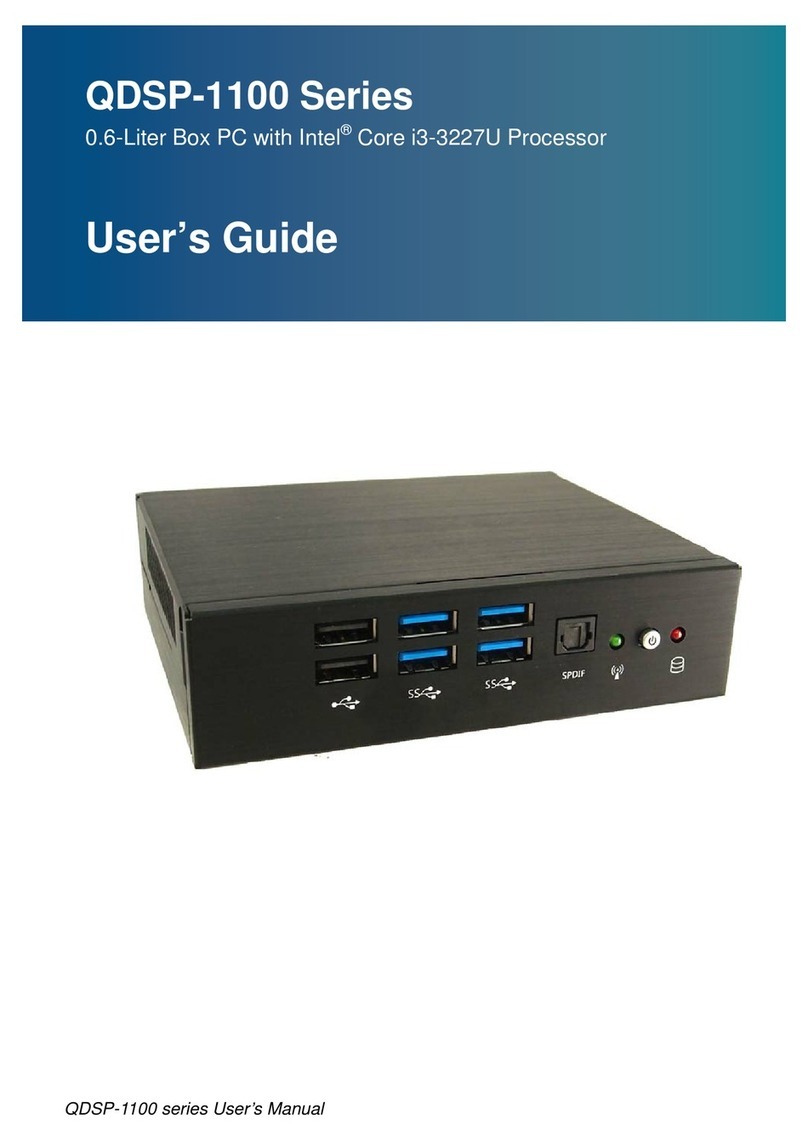
Quanmax
Quanmax QDSP-1100 Series user guide
